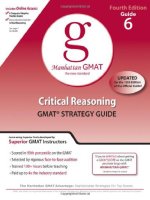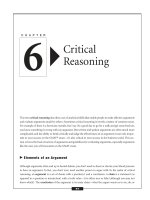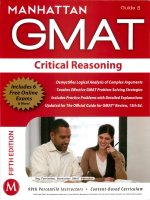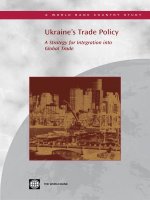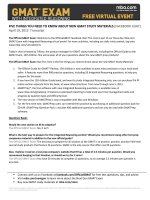gmat - strategy for critical reasoning
Bạn đang xem bản rút gọn của tài liệu. Xem và tải ngay bản đầy đủ của tài liệu tại đây (227.62 KB, 50 trang )
Strategy for Critical Reasoning
Provided by : piyusht
Aim
Logic, not Grammar
Critical Reasoning problems are among the
trickiest question types you’ll come across in the
GMAT.
That’s because CR problems are logic-based.
While an understanding of English grammar
rules is essential, your major challenge will be
simply to learn how ETS expects you to
approach the information within the sentences.
For many, this is the most feared part of the test!
Why do they fear it so?
Because the world as we know it is not logical.
By deconstructing a Critical Reasoning argument, you can more
clearly see what it is that’s missing.
Deconstructing an argument helps you notice illogical connections.
The tendency to make sense of what we read is natural and, for
the GMAT, fatal.
Fight your normal reading habits as you go through the questions
in this lesson.
With each CR question, you’ll be presented with
an argument. Don’t try to break down the
argument into its essential parts.
Instead, reorder the information.
Reorder the information; identifying the
premises and conclusion inherent within each
argument.
For Critical Reasoning questions, you must be purely and consistently
logical.
You: Let’s go see a movie.
Me: I have only two dollars.
Make sure you’re not brining outside information into your
reading of a Critical Reasoning problem.
We pose arguments all the time.
Often there is no logical connection between the information we
present (our premises) and our conclusions.
For example…
What is your conclusion?
We can’t go to a movie.
Because a movie costs more than two dollars.But why?
But how do we know this?
We don’t!
Don’t
assume
information
unless you
see it in the
argument!
Me: I can’t believe I saw Joe drinking a Coke.
You: Why?
Me: Because Joe works for Pepsi.
What’s your conclusion?
Joe prefers Coca Cola.
Joe hates his job.
Joe is a spy for Pepsi.
Be careful! What kinds of assumptions are you making to reach
these conclusions?
Here’s another example…
On Thursday I wore a blue shirt.
On Friday I had a headache.
Therefore, my blue shirt gives me a headache.
This is a dumbed-down version of a Critical Reasoning problem.
It’s easy to argue with my logic when I present my argument so
simply.
Be always suspicious of CR arguments. Fight with them. What
could you say that would undermine my argument?
Perhaps I was out all night last Thursday.
Maybe I live next door to an airport.
Any of these statements could severely undermine, or weaken,
my argument. And what could you add that would completely
destroy it?
What do you make of this one?
There’s no connection between the headache and the shirt
On Thursday I wore a blue shirt.
On Friday I had a headache.
My health is affected by the clothes I wear.
Therefore, my blue shirt gives me a headache.
This piece of information would completely destroy my argument.
And the reverse, that there is a direct connection between the
headache and the shirt, would completely fix it.
Now take a look at my revised argument…
You’ll never find an argument like this in a Critical Reasoning
problem. It’s too logical!
Your task as you approach CR questions will be
to break down an illogical argument into its
stated premises and conclusion.
If you can do this, you’ll be able to spot any trick
that ETS test-makers throw at you.
There are several different types of Critical Reasoning questions.
Differentiating between them is difficult, and you’ll have to know
the approach for each of them when you sit down to take the test.
Critical Reasoning questions ask you to do several things, but central to them all is having
an understanding of the basic structure of an argument.
Key Terms
Argument
Central to every CR question is the argument. An argument is an
ordered line of reasoning composed of premises, assumptions, and
a conclusion. Understanding the elements of an argument is
essential to performing well in this section.
Premise
Each CR argument contains at least one premise. Premises are
pieces of information that provide evidence used to support the
conclusion of the argument. For the purposes of Critical Reasoning
arguments, premises are facts not subject to dispute.
Conclusion
The conclusion is the endpoint of the line of reasoning of an argument.
Think of it as the result of the argument. The line of reasoning leading
to a conclusion is often where errors in logic are made.
Key Terms
Assumption
Assumptions are unstated facts and logical connections in an
argument. In order for the conclusion of an argument to be true, the
assumptions upon which that argument is based must also be true.
The Approach
Step 1: Read the question first.
Step 2: Read the argument.
Step 3: Paraphrase the argument using your own words.
Step 4: Predict the answer.
Step 5: Use the process of Error Identification to eliminate
the wrong answers.
The Approach
Critical Reasoning questions test your ability to
use basic logic to analyze and critique arguments
made up of premises and conclusions. ETS test-
makers write arguments that assume information
which doesn’t exist!
A logical and consistent approach is the best way
to avoid formulaic traps.
Follow these steps each time you attack Critical
Reasoning questions.
It’s natural to read the question after the argument because that’s how
they’re presented on the page. This is done for a reason.
Step 1: Read the question first.
Reading the argument first is confusing.
Read the question and determine what to look for within the answer
choices.
In general, you’ll be looking for the answer choices that either
strengthen or weaken the argument.
Think of answer choices as additional premises. Adding any one
answer choice to the argument will do one of three things:
1. It will weaken the argument.
2. It will strengthen the argument.
2. It will not affect the argument at all (neutral).
3. It has nothing to do with the argument (out of scope).
Determine which of the eight kinds of Critical Reasoning questions
you’re facing before turning to the argument itself.
Step 2: Read the argument.
1. Identify each premise (each piece of information) that is
being presented within the argument.
2. Identify the argument’s conclusion.
3. Determine what assumptions are being made.
Step 3: Paraphrase the argument using your own words.
Critical Reasoning arguments are intentionally heavy, wordy and
complex. Paraphrasing is a good way of understanding the sense an
argument presented.
Take the time, if necessary, and restate an argument, using words and
situations that you can relate to.
Note: This is the only step you’re permitted to skip. While it’s necessary
to understand the meaning of each argument (and paraphrasing is a
good tool to help you do this), restating or paraphrasing an argument
brings you unavoidably further away from the actual text.
Step 4: Predict the answer.
So, you’ve read the argument. You understand it. You can identify it’s
premises and it’s conclusion. Now imagine additional premises
(additional pieces of information) and what affect each would have on
the argument overall.
Brainstorm for a moment. Imagine which additional premise would
best strengthen the argument. What one thing could you add that
would completely fix it? Now imagine the opposite. How could you
weaken the argument? How could you completely destroy it?
This is perhaps the most important step in the process. Answer
choices are intentionally misleading, and you can use your predictions
as a measuring stick with which to compare the choices given to you
by ETS.
Think of answer choices as additional premises. As you read each
choice, ask yourself, “How would this additional premise affect the
strength or weakness of the argument’s conclusion?”
Categorize answer choices as one of the following:
1. Strengthen
2. Weaken
2. Neutral
3. Out of scope
Use the Process of Error Identification to get rid of any choices that do
not affect the conclusion (neutral) or have nothing to do with the
argument whatsoever (out of scope).
Whether you eliminate strengthen or weaken answer choices depends
on the question related with that argument.
Try the following Critical Reasoning example, using five steps…
Step 5: Use the Process of Error Identification to eliminate
the wrong answers.
In years past, professional baseball players lifted weights less but
were also injured less often during games. Obviously, the more
an athlete lifts weights, the higher the likelihood of injury.
The conclusion above presupposes which of the following?
(A) The increase in baseball injuries is due to a factor other than
weightlifting.
(B) The activities of baseball players represent those of athletes
as a group.
(C) Most baseball injuries today result from too much weight-
lifting.
(D) There is no proven correlation between how much athletes
lift
weights and how likely they are to be affected by injury.
(E) Weightlifting has always been common practice for
professional athletes.
First, read the question.
The conclusion above presupposes which of the following?
Premise #1: In years past, professional baseball players lifted
weights less.
Premise #2: But they were also injured less often during games.
Conclusion: Obviously, the more an athlete lifts weights, the
higher the likelihood of injury.
This is what’s called an assumption question. What specific piece of
information is presupposed (assumed) in the preceding argument?
Break it down to understand what the writer is really saying.
Can you identify the premises and the conclusion?
Restate or paraphrase the argument, if necessary. Stick as close to
the actual text as possible.
The correct answer is (B). Let’s see how it’s done…
If necessary, paraphrase the argument. Put the events in a context you
can understand, but stick as close to the actual text as possible. Try
changing the subjects without changing what they did.
Keep trying until the GMAT argument makes sense to you. Then return
to the actual argument!
Now, think about some of the big assumptions that are being made.
Ask yourself what you could add to fix the argument.
What could you add to the argument to completely destroy it!
If it helps, imagine someone you can’t stand. Think up a real or
fictional know-it-all. Now come up with the one thing you could say to
this person that would shut him up.
What if I offered evidence that proved baseball injuries are
definitely not a result of weightlifting? That might destroy the
argument. And the contrary, that baseball injuries definitely
are a result of weightlifting, might fix it.
What other assumptions can you come up with?
When you’re ready, turn your attention to the answer choices.
Use the Process of Error Identification to eliminate any answer choices
that are neutral or out of scope. For this particular question, also
eliminate any answer choices that weaken the argument.
(A) The increase in baseball injuries is due to a factor
other than weightlifting.
(B) The activities of baseball players represent those of
athletes as a group.
(C) Most baseball injuries today result from too much
weightlifting.
(D) There is no proven correlation between how much
athletes lift weights and how likely they are to be
affected by injury.
(E) Weightlifting has always been common practice for
professional athletes.
(A) The increase in baseball injuries is due to a factor
other than weightlifting.
(B) The activities of baseball players represent those of
athletes as a group.
(C) Most baseball injuries today result from too much
weightlifting.
(D) There is no proven correlation between how much
athletes lift weights and how likely they are to be
affected by injury.
(E) Weightlifting has always been common practice for
professional athletes.
Only answer choices (B) and (C) strengthen the argument.
Of course, there are many different kinds of athletes. All athletes are not
baseball players. The correct answer is (B).
Be aware of vague and undefined categories, such as “athletes.”
What’s wrong with answer choice (C) ? The trigger word “most” is
undefined. “Most” is a relative term, but we don’t know what it’s
relative to.
Weakens
Weakens
Neutral
In 1991, produce growers began using a new, inexpensive
pesticide, provoking many objections that they would damage
both the environment and the produce they were growing.
However, the fears have proven unfounded as, though 1996,
produce prices had dropped and no ill effects had been reported.
Which of the following, if true, would be the strongest
objection to the argument above?
(A) Consumption of the produce declined from 1991 to 1993, but
rose sharply from 1994 to 1996.
(B) Several areas in which use of the pesticide was forbidden
have also experienced a drop in produce prices.
(C) The amount of produce grown in 1991 was larger than that
of
1996.
(D) The time since the beginning of the use of the pesticide has
been too short to allow some of the predicted effects to
occur.
(E) Since 1992, new pesticides have been developed that
scientists agree are relatively risk-free.
Try one more…
(D) is the only answer choice that weakens the argument.
All the others, in fact, are out of scope!
Make it personal…
In 1991, I started smoking cigarettes. My friends said
it is unhealthy. In 2000, I am still Okay: Therefore;
cigarettes are not unhealthy.
There’s a fatal flaw to this logic. Look back and compare this
rephrasing with the actual argument itself.
Sorry, the
correct
answer is
(D).
(D) is the only answer choice that weakens the argument.
All the others, in fact, are out of scope!
Make it personal…
In 1991, I started smoking cigarettes. My friends said
it is unhealthy. In 2000, I am still Okay: Therefore;
cigarettes are not unhealthy.
There’s a fatal flaw to this logic. Look back and compare this
rephrasing with the actual argument itself.
Good job!
